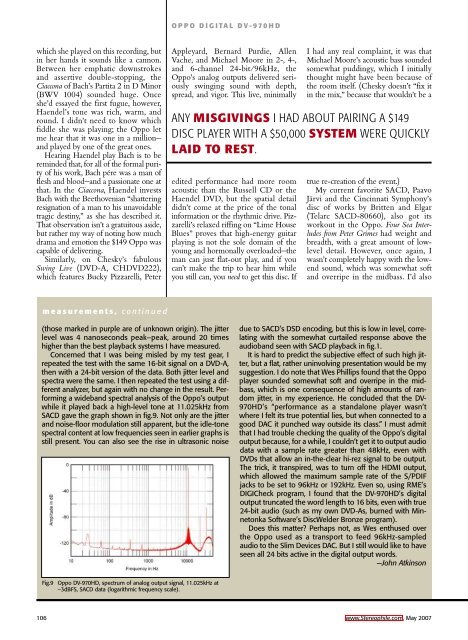home entertainment 2007
home entertainment 2007
home entertainment 2007
Create successful ePaper yourself
Turn your PDF publications into a flip-book with our unique Google optimized e-Paper software.
which she played on this recording, but<br />
in her hands it sounds like a cannon.<br />
Between her emphatic downstrokes<br />
and assertive double-stopping, the<br />
Ciaccona of Bach’s Partita 2 in D Minor<br />
(BWV 1004) sounded huge. Once<br />
she’d essayed the first fugue, however,<br />
Haendel’s tone was rich, warm, and<br />
round. I didn’t need to know which<br />
fiddle she was playing; the Oppo let<br />
me hear that it was one in a million—<br />
and played by one of the great ones.<br />
Hearing Haendel play Bach is to be<br />
reminded that, for all of the formal purity<br />
of his work, Bach pére was a man of<br />
flesh and blood—and a passionate one at<br />
that. In the Ciaccona, Haendel invests<br />
Bach with the Beethovenian “shattering<br />
resignation of a man to his unavoidable<br />
tragic destiny,” as she has described it.<br />
That observation isn’t a gratuitous aside,<br />
but rather my way of noting how much<br />
drama and emotion the $149 Oppo was<br />
capable of delivering.<br />
Similarly, on Chesky’s fabulous<br />
Swing Live (DVD-A, CHDVD222),<br />
which features Bucky Pizzarelli, Peter<br />
measurements, continued<br />
OPPO DIGITAL DV-970HD<br />
(those marked in purple are of unknown origin). The jitter<br />
level was 4 nanoseconds peak–peak, around 20 times<br />
higher than the best playback systems I have measured.<br />
Concerned that I was being misled by my test gear, I<br />
repeated the test with the same 16-bit signal on a DVD-A,<br />
then with a 24-bit version of the data. Both jitter level and<br />
spectra were the same. I then repeated the test using a different<br />
analyzer, but again with no change in the result. Performing<br />
a wideband spectral analysis of the Oppo’s output<br />
while it played back a high-level tone at 11.025kHz from<br />
SACD gave the graph shown in fig.9. Not only are the jitter<br />
and noise-floor modulation still apparent, but the idle-tone<br />
spectral content at low frequencies seen in earlier graphs is<br />
still present. You can also see the rise in ultrasonic noise<br />
Fig.9 Oppo DV-970HD, spectrum of analog output signal, 11.025kHz at<br />
–3dBFS, SACD data (logarithmic frequency scale).<br />
Appleyard, Bernard Purdie, Allen<br />
Vache, and Michael Moore in 2-, 4-,<br />
and 6-channel 24-bit/96kHz, the<br />
Oppo’s analog outputs delivered seriously<br />
swinging sound with depth,<br />
spread, and vigor. This live, minimally<br />
edited performance had more room<br />
acoustic than the Russell CD or the<br />
Haendel DVD, but the spatial detail<br />
didn’t come at the price of the tonal<br />
information or the rhythmic drive. Pizzarelli’s<br />
relaxed riffing on “Lime House<br />
Blues” proves that high-energy guitar<br />
playing is not the sole domain of the<br />
young and hormonally overloaded—the<br />
man can just flat-out play, and if you<br />
can’t make the trip to hear him while<br />
you still can, you need to get this disc. If<br />
I had any real complaint, it was that<br />
Michael Moore’s acoustic bass sounded<br />
somewhat puddingy, which I initially<br />
thought might have been because of<br />
the room itself. (Chesky doesn’t “fix it<br />
in the mix,” because that wouldn’t be a<br />
ANY MISGIVINGS I HAD ABOUT PAIRING A $149<br />
DISC PLAYER WITH A $50,000 SYSTEM WERE QUICKLY<br />
LAID TO REST.<br />
true re-creation of the event.)<br />
My current favorite SACD, Paavo<br />
Järvi and the Cincinnati Symphony’s<br />
disc of works by Britten and Elgar<br />
(Telarc SACD-80660), also got its<br />
workout in the Oppo. Four Sea Interludes<br />
from Peter Grimes had weight and<br />
breadth, with a great amount of lowlevel<br />
detail. However, once again, I<br />
wasn’t completely happy with the lowend<br />
sound, which was somewhat soft<br />
and overripe in the midbass. I’d also<br />
due to SACD’s DSD encoding, but this is low in level, correlating<br />
with the somewhat curtailed response above the<br />
audioband seen with SACD playback in fig.1.<br />
It is hard to predict the subjective effect of such high jitter,<br />
but a flat, rather uninvolving presentation would be my<br />
suggestion. I do note that Wes Phillips found that the Oppo<br />
player sounded somewhat soft and overripe in the midbass,<br />
which is one consequence of high amounts of random<br />
jitter, in my experience. He concluded that the DV-<br />
970HD’s “performance as a standalone player wasn’t<br />
where I felt its true potential lies, but when connected to a<br />
good DAC it punched way outside its class.” I must admit<br />
that I had trouble checking the quality of the Oppo’s digital<br />
output because, for a while, I couldn’t get it to output audio<br />
data with a sample rate greater than 48kHz, even with<br />
DVDs that allow an in-the-clear hi-rez signal to be output.<br />
The trick, it transpired, was to turn off the HDMI output,<br />
which allowed the maximum sample rate of the S/PDIF<br />
jacks to be set to 96kHz or 192kHz. Even so, using RME’s<br />
DIGICheck program, I found that the DV-970HD’s digital<br />
output truncated the word length to 16 bits, even with true<br />
24-bit audio (such as my own DVD-As, burned with Minnetonka<br />
Software’s DiscWelder Bronze program).<br />
Does this matter? Perhaps not, as Wes enthused over<br />
the Oppo used as a transport to feed 96kHz-sampled<br />
audio to the Slim Devices DAC. But I still would like to have<br />
seen all 24 bits active in the digital output words.<br />
—John Atkinson<br />
106 www.Stereophile.com, May <strong>2007</strong>

















